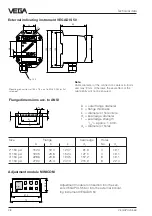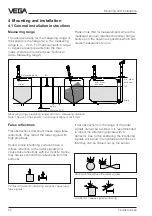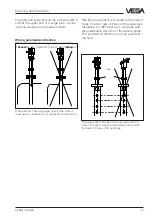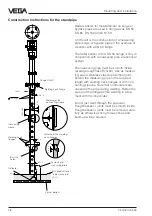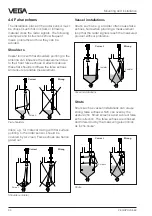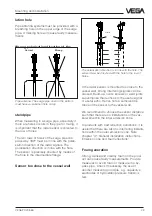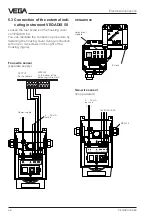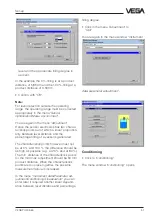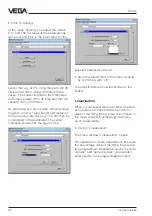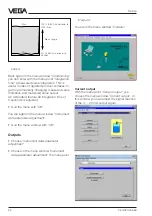
VEGAPULS 56K
39
Mounting and installation
,,,,,,,,,,,,,,,,,,,,,,,,,,,,,,,,
,,,,,,,,,,,,,,,,,,,,,,,,,,,,,,,,
0 %
~45˚
ø 100,8
0
,0
…
0
,4
1,5…2
3,6
0
,0
…
0
,4
1
5
0
…
5
0
0
5
…
1
5
3,6
ø 96
2
100 %
Flange DN 100
Smooth weld-
ing flange
Connecting
sleeve
Welding neck
flanges
Welding of the smooth
welding flange
Welding of the welding
neck flange
Fastening of
measuring
pipe
Vessel bottom
Deflector
On the left you see the construction of a meas-
uring pipe on the example of a radar sensor
with a DN␣ 100 flange.
Radar sensors with flanges of DN␣ 80,
DN␣ 100␣ and DN␣ 150 are equipped with a horn
antenna. Instead of the welding neck flange
also a smooth welding flange can be used on
the sensor side of these sensors.
In agitated products, fasten the measuring
pipe to the vessel bottom. Provide additional
fastenings for longer measuring pipes.
With the deflector on the measuring pipe end,
the radar signals are reflected from the vessel
bottom. This avoids that in nearly empty vessel
and products with low dielectric constants, not
the measured product but the vessel bottom is
detected. In products with low dielectric con-
stant figures the product is penetrated by
radiation and the vessel bottom delivers at low
level considerably clearer radar echoes than
the product surface.
Due to the deflector the useful signal remains
and hence the measured value can be clearly
detected in nearly empty vessel and the 0␣ %-
level is reliably detected.
Rz
≤
30
Burr the
holes
Min. product
level to be
measured
(0␣ %)




